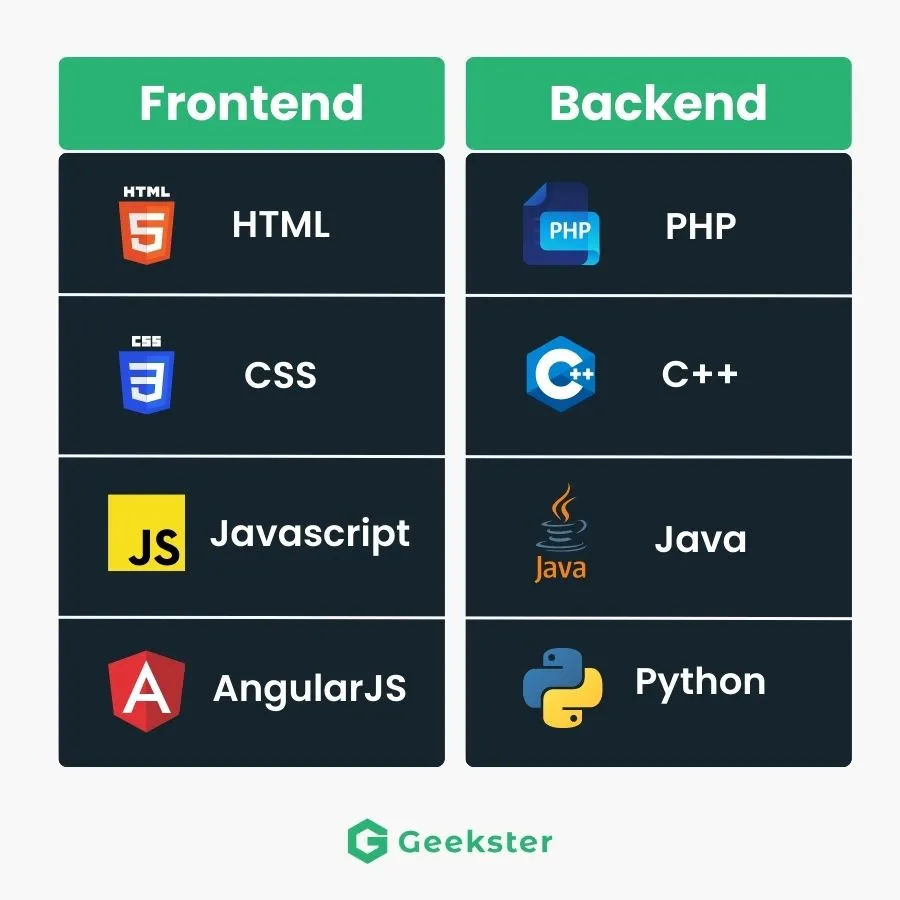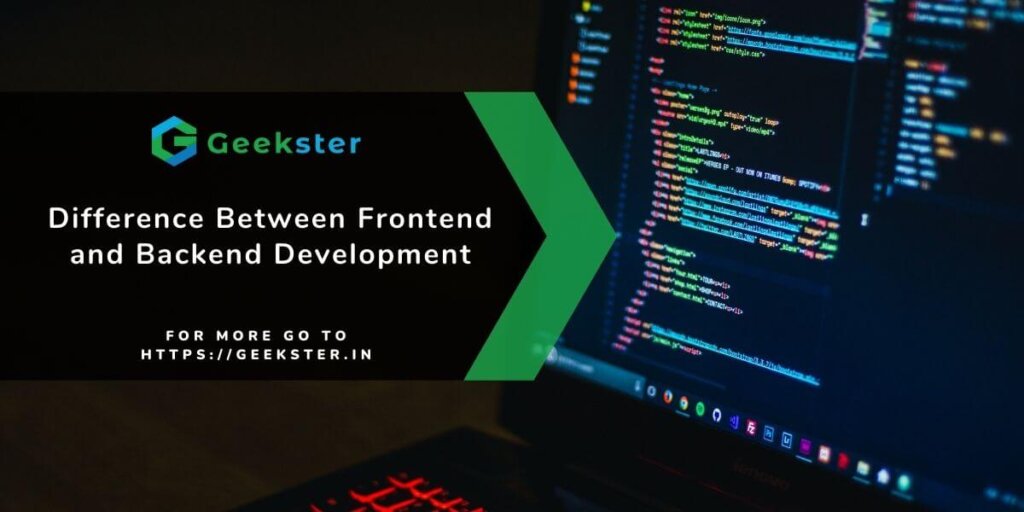If you are new to coding, you might get confused about how a website or an application takes shape. In the programming world, you often hear about frontend and backend, and then there are full stack developer languages. If you are wondering what all these have to do with building a website, what is frontend and back end? What is full-stack? How these work and so on.
We get it. We had the same questions when we were you. We too wanted to know about what is the difference between front end and back end development.
In this article we will learn about:
- What is frontend?
- What is backend?
- Frontend vs Backend- the difference between the two.
- What are the frontend and backend languages?
- What is full-stack development?
So, let’s get started.
Web development is basically building websites and apps; and includes a lot of coding. Now when it comes to the usability of the website or an application, it has two components that come together to form a usable website/application – Frontend and Back end.
A frontend is what the users see and the backend is the infrastructure that supports the application/website.
These two are the two sides of the coin and both of them depend on each other. The front end is the part that is visible to the users while the backend is the non-visible part upon which the whole functioning depends.
What is Frontend and Backend Development?
1. Frontend Development
Frontend development includes designing how the website will look like. It deals with details about the website that the users see, features that the user uses to communicate with you, navigation menus, images-animations-videos, etc. The front end of the website/application decides how good of an experience the user gets.
A front end is developed keeping the user in mind and ensuring that the visual aspects of the website function properly. It is basically developing the client-side of the website and bringing the visual elements to life. A front end developer works with UX and UI designers to build the elements like:
- Layouts
- Navigation
- Buttons
- Graphics
- Images
- Animation
- Content organization and placement, etc.
Skills of a Frontend Developer:
- Finding solutions to design problems
- Create and modify static pages to conform to HTML
- Analyze the client-side performance of the web app by developing a better understanding of the user experience.
- Deploying interactive and mobile-friendly apps for the web using the latest technologies

2. Backend Development
The backend deals with the hidden side of the website/application that the user cannot see but makes the website functional. It handles all the nitty-gritty of it like storage and data organization, communicating with the front end to ensure smooth functioning, etc. It is known as the server-side of the website. When any user interacts with the website in the form of making a purchase, filling a form, entering information, etc. The backend manages and processes the information input and returns relevant information that is displayed on the screen through the frontend. This information and all the content on the website are stored in the database.
A backend developer ensures that the frontend elements function properly when users browse or upload any information on the website. The users do not interact with the back end directly but they use the front end elements to interact with the backend.
A backend developer works on:
- Coding the core of the website
- Debugging and troubleshooting
- Database management
- Framework utilization
- Server management, etc.
Skills of a Backend Developer:
- In-depth understanding of databases and servers
- Problem-solving attitude toward complex programming problems
- Ability to identify and fix bottlenecks
- Knowhow to make an app stable, faster, and secure
Frontend And Backend Languages
To develop a website or an application, a developer uses programming languages to develop the frontend and backend. There are separate languages for the front end and backend that a developer uses to create a fully functional website.
Frontend Languages
- HTML– Used to create a structure of the web pages
- CSS – It is used to apply styles to web pages and make them presentable
- Javascript – It is used to make the website interactive and enhance the functionality
While these are just languages that are used to develop a website, there are web development frameworks and libraries that ease the development process. Some of the most used front end frameworks and libraries are:
- AngularJS: It is an open-source JavaScript frontend framework that is used for developing mostly single-page websites and web apps. It is very popular among developers because it converts static HTML to dynamic HTML.
- ReactJS: It is a declarative component-based JavaScript library for developing the user interface.
- jQuery: This open-source JavaScript library simplifies the interaction between JavaScript and DOM.
- Flutter: This is an open-source UI development SDK.
- SASS: This is a CSS extension language that is used to extend the functionality of the existing CSS

Backend Languages
The following languages are used predominantly to develop the backend
- PHP – A server-side scripting language
- C++ – A general-purpose language for programming
- Python – A programming language that enables quick development and system integration
- Java – A highly scalable programming language.
- JavaScript – A multipurpose language that can be used for both frontend and back end
- NodeJS – An open-source runtime platform that is used for executing Javascript codes outside the browser and for building APIs.
For the backend, these frameworks are used for faster and more efficient web development
Express, Django, Rails, Spring, Ruby, REST, C#, GO, etc.
What Are The Other Significant Differences Between Front end and Back end Development?
What we have talked about so far was the overview of the difference between the two. Now let’s understand a little deeper about how these two are separate job roles, Frontend Vs Backend.
| Differences | Frontend Development | Backend Development |
| Working on Different Sides of the Website or Application | Frontend programming focuses on building the visual elements that users see and interact | The backend focuses on the server-side that users cannot see. These two combine together to form a dynamic website. |
| Use of Different Programming Languages | HTML & CSS , Python, Javascript, etc. | Ruby, Java, PHP, etc. |
| Working with different teams | Frontend developers work exclusively with clients, management, UI/UX team | backend development team while backend developers work with business stakeholders, management, and frontend developers |
| Difference in Pay | Frontend developers can get lower pay than backend developers | Backend developers can get higher pay than frontend developers |
Full Stack Web Development
With that being said, these days Full Stack developers are the most demanded developers as they manage both the frontend and backend of the website. They also get higher pay than frontend and backend developers for wearing many hats and expertise in all the sections of the development process. Before all, you should know what is frontend and backend languages
The differences in the role a frontend developer and a backend developer play, cannot be undermined by saying one is important and the other is not. Both of them are necessary for the development of a functional and appealing website or application.
If you are considering a career in website and application development, then why not go for something that is in high demand these days and includes both of these roles. By being a Full Stack developer you will get the best of both worlds. You can consider taking a 5-6 months course to equip yourself with the in and out of the Full Stack Web development and join the hottest job industry.
FAQs
Answer – Full Stack Development is one of the most demanded job profiles currently. Since a full-stack developer can perform the job role of both Frontend and Backend developer, companies these days prefer to have one expert to do the entire job.
Answer – While both frontend and backend developments are equally important, the backend entails a lot more technicalities compared to the frontend. However, the difficulty of the course depends on your learning and the guidance provided to you during the course.
Answer – You can become a Full Stack Developer by joining Geekster’s full-stack web development programs which teach you everything about full-stack development while also training you to face interviews.
Answer – Yes, you can get a job with a certificate course in Full Stack Development. While companies do require an associate degree, you can bag a job for yourself with good hands-on training and certification from a reputed academy.

